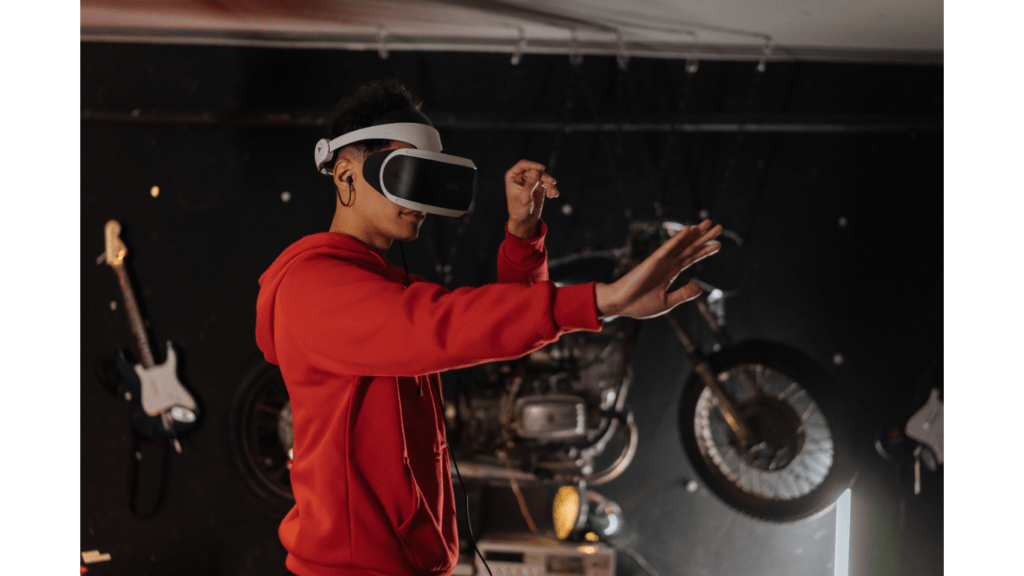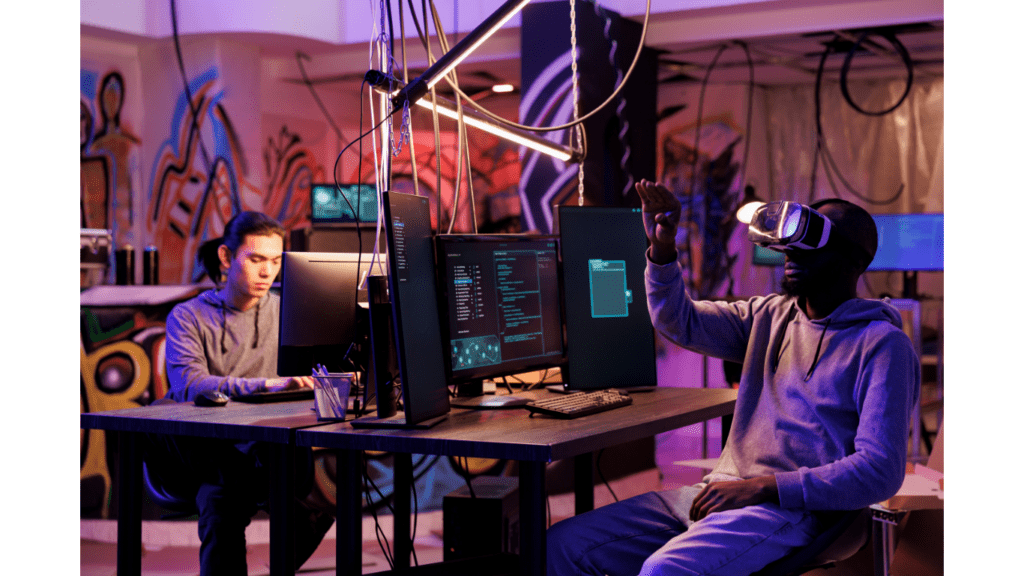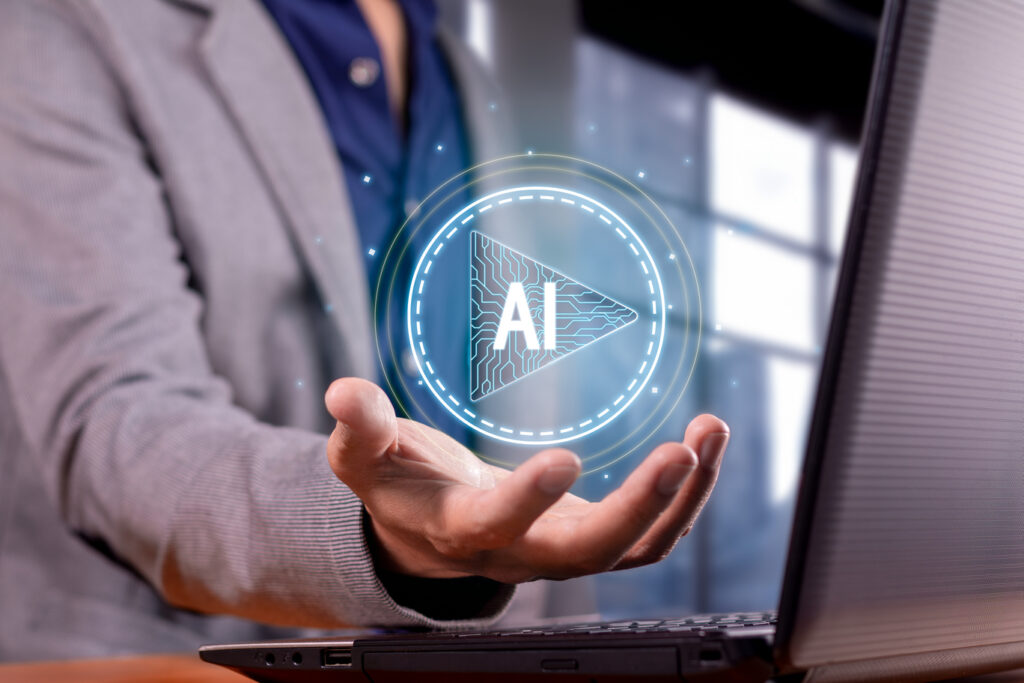Understanding Augmented Reality
History and Evolution of AR
- Exploring the history of augmented reality gives us insights into its evolution and transformative journey. AR technology traces its roots back to the late 20th century when computer scientist Tom Caudell coined the term “augmented reality” in the early 1990s. Initially used for pilot training in the aviation industry, AR has come a long way since then. Over the years, advancements in hardware capabilities and software sophistication have propelled AR into mainstream applications across a wide range of industries.
How AR Works
- Understanding how augmented reality works is fundamental to grasping its significance in transforming industries. At its core, AR overlays digital information such as images, videos, or 3D models onto the real world, enhancing the user’s perception and interaction with their environment. This is achieved through a combination of technologies like computer vision and sensor data, which enable AR devices to recognize objects and surfaces in real-time, aligning digital content seamlessly within the physical space. By blending virtual elements with the real world, AR creates immersive experiences that revolutionize how we visualize data, learn new concepts, and engage with products and services.
AR in Different Industries
Healthcare Innovations with AR
- In healthcare, AR has revolutionized medical procedures, training, and patient care. It allows surgeons to overlay vital information during operations, enhancing precision and reducing risks. For example, AR can provide real-time patient data, 3D visualizations of organs, and navigation guidance during surgeries. Medical students benefit from AR simulations for hands-on learning, improving diagnostic skills in a controlled environment. Patients experience better understanding of complex medical conditions through interactive AR models, leading to improved treatment outcomes. The integration of AR in healthcare continues to drive advancements that prioritize accuracy and patient well-being.
Retail Experiences Enhanced by AR
- The retail sector embraces AR to enhance customer engagement and reinvent shopping experiences. AR applications enable virtual try-ons for clothing and accessories, allowing customers to visualize products before purchase. Interactive AR features in stores create immersive environments where shoppers can access product information, reviews, and promotions in real time. Brands leverage AR to bridge the gap between online and offline shopping, offering personalized recommendations and seamless shopping journeys. By integrating AR technology, retailers cater to evolving consumer preferences and deliver memorable shopping interactions that drive sales and brand loyalty.
Impact on Education and Training
- AR transforms traditional learning methods by providing interactive and engaging educational experiences. Students benefit from visualizing complex concepts through AR simulations, enhancing retention and understanding. Educators use AR to create interactive lessons, virtual field trips, and 3D models that facilitate active learning. Training programs across various industries integrate AR for hands-on simulations, improving skill development and knowledge retention. By introducing AR into educational settings, institutions adapt to modern learning styles, preparing students for dynamic professional landscapes with practical skills and enhanced engagement.
AR in Manufacturing and Maintenance
- In manufacturing, AR streamlines processes, enhances productivity, and ensures quality control. AR-powered smart glasses provide assembly line workers with real-time instructions, reducing errors and improving efficiency. Maintenance technicians utilize AR overlays to access equipment manuals, troubleshooting guides, and remote assistance, minimizing downtime. By integrating AR into manufacturing workflows, companies optimize operations, reduce training time, and empower employees with on-demand support. The adoption of AR in manufacturing drives innovation, cost savings, and operational excellence by leveraging data-driven insights and enhancing collaboration.
Augmented Reality in Gaming
- Gaming experiences are elevated through AR technologies that blend virtual elements with the real world. AR games offer immersive gameplay by overlaying digital content onto physical environments, creating interactive and engaging scenarios. Players interact with virtual characters and objects in real-time, fostering active participation and social engagement. AR gaming applications encourage physical movement, exploration, and problem-solving, enhancing players’ cognitive skills and overall experience. The integration of AR in gaming opens new possibilities for interactive storytelling, multiplayer experiences, and location-based gameplay, shaping the future of entertainment with innovative and captivating gaming experiences.
Key Technologies Driving AR

1. Advances in Mobile Computing
Innovations in mobile computing have been pivotal in propelling the widespread adoption of augmented reality. Mobile devices have become powerful tools capable of handling complex AR applications seamlessly. With the advent of high-performance processors, advanced sensors, and increased storage capacities, smartphones and tablets can deliver immersive AR experiences with impressive speed and precision. This capability has opened up opportunities for AR integration across various industries, enhancing user engagement and transforming the way businesses interact with their customers.
2. Breakthroughs in AR Hardware
The continuous evolution of AR hardware has significantly contributed to the enhancement of AR experiences. From lightweight AR glasses to advanced headsets, the hardware components have become more compact, ergonomic, and efficient. Improved display technologies, such as high-resolution screens and wide field of view optics, have enabled users to perceive digital content seamlessly blended with the physical environment. Additionally, enhancements in tracking sensors and depth cameras ensure accurate spatial mapping and interaction within AR environments. These advancements in AR hardware are revolutionizing industries by offering new possibilities for training, visualization, and real-time data overlay in various applications.
Software Development for AR Experiences
Software development plays a crucial role in shaping captivating AR experiences that drive user engagement and innovation. The creation of AR applications requires specialized programming skills and tools tailored to design interactive and immersive content. Developers utilize AR software kits and frameworks that enable seamless integration of digital elements into real-world scenarios. By leveraging cutting-edge technologies like computer vision, machine learning, and spatial mapping, developers can enhance the realism and interactivity of AR applications. Moreover, the optimization of AR software for different platforms ensures a consistent user experience across devices, further expanding the reach and impact of AR technology in diverse sectors.
Challenges and Considerations
Technical Limitations and Privacy Concerns
- In the realm of augmented reality (AR), there are several technical limitations that pose challenges to widespread adoption. One primary issue is the hardware constraints of current AR devices, which often struggle to deliver seamless and realistic user experiences. These limitations can include restricted field of view, insufficient processing power, and limited battery life. As AR applications become more sophisticated and demanding, overcoming these technical barriers is essential to unlocking the full potential of AR across industries.
- Privacy concerns also loom large in the AR landscape. The integration of digital elements into the physical environment raises questions about data privacy and security. Users may be hesitant to engage with AR technologies if they perceive a risk to their personal information or if they feel that their privacy is being compromised. Addressing these privacy concerns through robust data protection measures and transparent data handling practices is crucial to building trust with users and promoting the responsible use of AR technologies.
The User Experience and Adoption Hurdles
- Creating a seamless and intuitive user experience is paramount for the widespread adoption of AR applications. Complex user interfaces, cognitive overload, and inconsistent interaction patterns can deter users from embracing AR technology. Designing AR experiences that are user-friendly, intuitive, and accessible to a wide range of users is essential to driving adoption across industries.
- Moreover, overcoming adoption hurdles requires addressing challenges related to awareness, education, and accessibility. Many potential users may lack awareness of the capabilities and benefits of AR, hindering its adoption. Educating users about the value proposition of AR, providing training and support, and ensuring accessibility for users with disabilities are critical steps in overcoming adoption barriers and fostering a more inclusive AR ecosystem.
Future of Augmented Reality
Emerging Trends in AR
Augmented Reality (AR) is poised to revolutionize numerous industries in the coming years. As technology continues to advance rapidly, several emerging trends are shaping the future of AR applications. One significant trend is the integration of AR in e-commerce, with major retailers incorporating AR features into their online platforms to enhance the shopping experience. This trend allows customers to visualize products in their physical space before making a purchase, leading to increased sales and customer satisfaction.
Another key trend is the use of AR in healthcare for training, diagnostics, and treatment purposes. Healthcare professionals can leverage AR technology to simulate medical procedures, improve patient outcomes, and enhance medical training programs. This trend is expected to contribute to significant advancements in the healthcare sector, ultimately benefiting both healthcare providers and patients.
Predictions for AR’s Impact on Society
Looking ahead, the impact of Augmented Reality on society is projected to be profound. With the increasing integration of AR into everyday life, we can anticipate significant changes in various aspects of society. One prediction is the widespread adoption of AR in education, transforming traditional learning methods into interactive and immersive experiences. Students will have the opportunity to engage with educational content in innovative ways, leading to enhanced learning outcomes and increased student engagement.
Furthermore, AR is expected to play a vital role in the evolution of smart cities, enabling more efficient urban planning, transportation systems, and public services. By overlaying digital information onto the physical environment, AR technology can enhance the way people interact with their surroundings and access essential services in urban areas. This transformation is likely to result in improved quality of life, environmental sustainability, and overall urban development.
The future of Augmented Reality holds tremendous potential for reshaping industries and society at large. By staying informed about emerging trends and predictions for AR’s impact on society, we can prepare for a future where AR technologies are seamlessly integrated into various aspects of our lives, unlocking new possibilities and opportunities for innovation.




